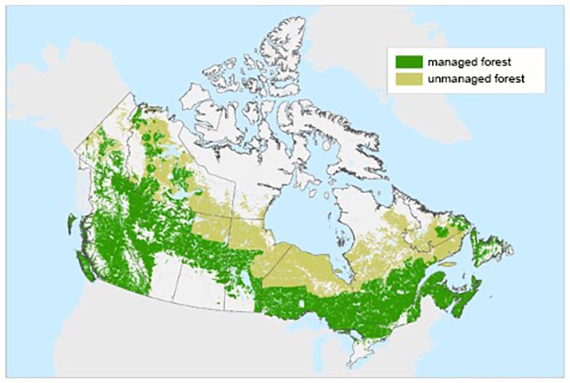The Canadian Forest Service uses its science-based National Forest Carbon Monitoring, Accounting and Reporting System (NFCMARS) and its Carbon Budget Model of the Canadian Forest Sector (CBM-CFS3) to develop annual greenhouse gas (GHG) estimates of the amount of carbon released to and removed from the atmosphere, as well as carbon transfers within Canada’s managed forest.

Changes in these estimates over time are also calculated. For example:
- estimates of past years can be updated/ recalculated due to methodological improvements
- projections of changes over time are developed and updated each year
Environment and Climate Change Canada (ECCC) combines these estimates with those from other sectors of the economy. This information is incorporated into Canada’s greenhouse gas (GHG) inventory.
Each year, this inventory is submitted to the United Nations Framework Convention on Climate Change (UNFCCC). The UNFCCC secretariat organizes teams of international experts to review Canada’s inventory and ensure that it complies with reporting requirements.
In keeping with international guidelines, Canada’s approach separates forest GHG fluxes in the managed forest due to human activities from those resulting from wildland fire, insect outbreaks and other natural disturbances. This differentiation ensures that Canada’s GHG inventory provides an accurate representation of the influences of human (anthropogenic) activities on forest carbon, such as harvesting and reforestation.
Spatially explicit forest carbon modelling is important for achieving many significant improvements to forest GHG estimates. NFCMARS incorporates information that varies across Canada at the scale of forest management units. It cannot provide estimates for specific locations. The next version of NFCMARS will include spatially-explicit forest carbon models and make better use of remote sensing data.
Research is improving estimates of the carbon impacts of forest management including from activities that improve tree growth, or that delay or result in no forest regeneration on logging access roads and landings. Work is ongoing to better quantify the impacts of natural disturbances and climate change on forest growth and decomposition rates.
NFCMARS and the CBM-CFS3
Canada’s forest carbon reporting system — the National Forest Carbon Monitoring, Accounting and Reporting System (NFCMARS) and the Carbon Budget Model (CBM-CFS3) — are internationally recognized. They are used in many countries to estimate and understand forest GHG fluxes.
NFCMARS estimates:
- the amount of forest carbon stocks (atmospheric carbon dioxide captured and stored within the forest ecosystem)
- changes in forest carbon stocks
- carbon stocks of harvested wood
- emissions from various harvested wood products
- emissions of other GHGs in Canada’s managed forests
The modelling framework integrates information on forest growth and disturbance from a wide variety of sources including:
- provincial forest inventories
- temporary and permanent sample plots
- forest growth and yield estimates
- remote sensing measurements
- statistics on natural disturbances such as wildland fire and forest insect infestations
Included is an assessment of carbon in:
- all parts of living trees
- tree trunks
- leaves or needles
- branches
- roots
- dead wood
- forest floor litter
- dead leaves or needles
- twigs
- small branches
- mineral soil
- harvested wood products
The modelling framework uses the best available data and scientific understanding of ecological processes that affect forests. It also tracks what happens to forest carbon when natural disturbances or harvesting occur.
The impact of natural disturbances
The GHG impacts of natural disturbances such as wildland fire and severe forest insect outbreaks are measured in Canada’s GHG inventory because understanding the total emissions and removals from our managed forest is very important.
To provide a clear picture of the impacts of human activity over time, the focus of Canada’s GHG inventory report is the emissions, removals and transfers that are a direct result of forest management practices. Having a clear understanding of direct human impacts can inform how we develop approaches to reduce carbon emissions and increase the carbon sequestered by our forests. For this reason, emissions and removals associated with natural disturbances are tracked and reported separately.
The impact of timber harvesting
The estimates incorporate emissions from timber harvesting, specifically the decay or burning of harvest residues (treetops, stumps, branches, roots) left in the forest. The regrowth of a forest after harvest, whether from tree planting or natural regeneration, is considered part of the impact of harvesting timber.
A regenerating forest is typically a net source of carbon in the first few years after harvest, but transitions to an increasingly larger net sink as the trees grow. The rate of sequestration can vary by forest type and tree species, depending on the location in Canada.
The fossil fuel emissions from equipment used in timber harvesting and other forestry operations are not included in the managed forest GHG estimates because they are included in the GHG inventory under other categories such as transportation emissions. However, the impact of emissions from harvested wood products is calculated and reported. Information on harvesting and other forest management activities helps track trends in forest management.
Governments in Canada are exploring and implementing initiatives aimed at reducing forest carbon emissions and increasing removals; including the Government of Canada’s commitment to plant two billion trees. The impact of these investments is reflected in the forest GHG inventory estimates.